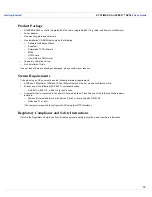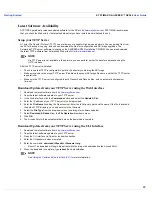
Getting Started
SYSTIMAX® AirSPEED™ AP542
User Guide
17
The LED indicators exhibit the following behavior:
Installation in the Plenum (North America Only)
In an office building, the plenum is the 18 inches of space located above office ceiling tiles used to house the
structured cabling infrastructure. All products located in the plenum must comply with specific safety instructions, such
as Underwriter Labs (UL) Standard 2043: “Standard for Fire Test for Heat and Visible Smoke Release for Discrete
Products and Their Accessories Installed in Air-Handling Spaces”.
The AirSPEED AP542 has been certified under UL Standard 2043 and can be installed in the plenum.
SYSTIMAX recommends that an AirSPEED AP542 that is installed in the plenum be powered by Power over Ethernet
and use a minimum of one Signal Enhancing Antenna (SEA) per radio.
Prerequisites (for AP Configuration Only)
Before installing an AirSPEED AP542, you need to gather certain network information. The following section identifies
the information you need.
Indication
Power
Wireless Interface A
(802.11a radio)
Wireless Interface B
(802.11b/g radio)
Ethernet
Solid Green
AP image running.
Wireless interface A is
preparing for use.
Wireless interface B is
preparing for use.
Ethernet interface is
connected at 100 Mbps with
no traffic
Blinking
Green
n/a
Wireless interface A is
transmitting or receiving
wireless packets.
Wireless interface B is
transmitting or receiving
wireless packets.
Ethernet interface is
connected at 100 Mbps with
traffic
Solid Yellow
n/a
n/a
n/a
Ethernet interface is
connected at 10 Mbps with
no traffic
Blinking
Yellow
n/a
n/a
n/a
The Ethernet interface is
connected at 10 Mbps with
traffic
Solid Amber
The Bootloader is loading
the application software.
n/a
n/a
n/a
Blinking
Amber
The AP is reloading.
n/a
n/a
n/a
Solid Red
Power On Self Test (POST)
running.
n/a
n/a
n/a
Blinking Red
Rebooting.
n/a
n/a
n/a
Network Information
Description
Network Name (SSID of the embedded radios) You must assign the Access Point a Network Name before wireless users can
communicate with it. The clients also need the same Network Name. This is not the same
as the System Name, which applies only to the Access Point. The network administrator
typically provides the Network Name.
AP’s IP Address
If you do not have a DHCP server on your network, then you need to assign the
Access Point an IP address that is valid on your network.
HTTP Password
Each Access Point requires a read/write password to access the web interface. The default
password is “public”.
CLI Password
Each Access Point requires a read/write password to access the CLI interface. The default
password is “public”.
SNMP Read Password
Each Access Point requires a password to allow get requests from an SNMP manager.
The default password is “public”.
SNMP Read-Write Password
Each Access Point requires a password to allow get and set requests from an SNMP
manager. The default password is “public”.
SNMPv3 Authentication Password
If Secure Management is enabled, each Access Point requires a password for sending
authenticated SNMPv3 messages. The default password is “public”.
SNMPv3 Privacy Password
If Secure Management is enabled, each Access Point requires a password when sending
encrypted SNMPv3 data. The default password is “public”.






























